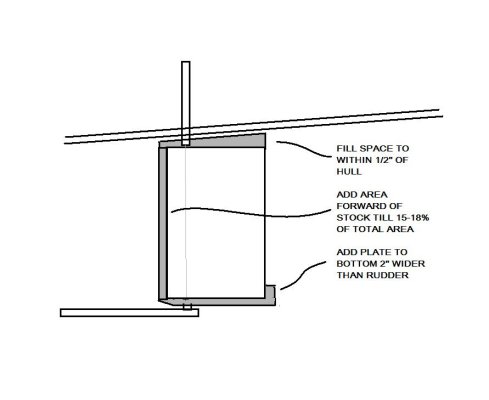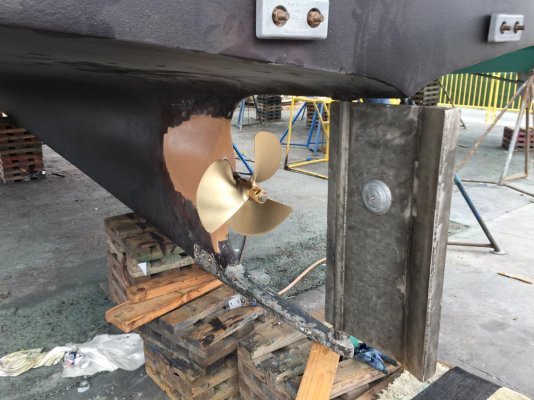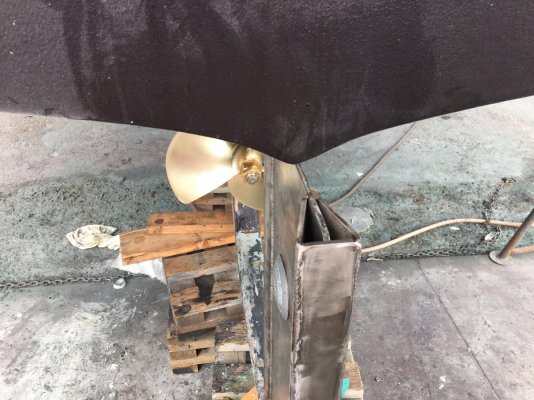You are using an out of date browser. It may not display this or other websites correctly.
You should upgrade or use an alternative browser.
You should upgrade or use an alternative browser.
Boat handling characteristics
- Thread starter Shrew
- Start date
The friendliest place on the web for anyone who enjoys boating.
If you have answers, please help by responding to the unanswered posts.
If you have answers, please help by responding to the unanswered posts.
Al
Guru
- Joined
- Apr 1, 2012
- Messages
- 2,206
- Location
- usa
- Vessel Name
- 'SLO'~BELLE
- Vessel Make
- 1978 Marben-27' Flybridge Trawler(extended to 30 feet) Pilothouse Pocket Cruiser[
Still no picture but here's a sketch
Thanks for that! Now, I looked at a photo of my rudder. I include the site of a sister boat and unfortunely, I am not able to cherry pick the photo so bear with me and scrool through till you see a photo of the rudder.
1978 Marben Flybridge Trawler Pilothouse Pocket Cruiser Title
It would appear that the gain would be some, but would it be enough to support a new or modified rudder? Maybe a temporary plywood overlay for a test period.
Seeing what the anticipated auto pilot will perform will tell the tale.
Al-Ketchikan
Lou_tribal
Guru
What is the model of your rudder cylinder and helm pump, this would help to determine if your 8 turns L to L is something normal.
L.
L.
- Joined
- Apr 15, 2008
- Messages
- 13,731
- Location
- California Delta
- Vessel Name
- FlyWright
- Vessel Make
- 1977 Marshall Californian 34 LRC
That bottom plate on Brooksies rudder behaves exactly as an airplane's winglet behaves at the end of the wing. The outer portion on the opposite side would lose much of its 'lift' caused by the pressure differential once the high pressure leaks to that side. By containing the high pressure fluid on the high pressure side, you make the rudder (and wing) more effective.
questionmark
Senior Member
I'm with Art. Somebody will have a photo or two. somebody
Here's two from mine. This wedge made the trawler (1979 C&L 37) an entirely different boat. It actually has some steerage without power. Before, the boat was like a giant jet-ski, it would only turn under power. Now I can turn even when traveling slowly.
I had originally talked to the yard guys about adding some rudder in front of the post to help with the steering, but they really recommended the wedge. They were right. It's night and day.
Josh
Attachments
Something that just hit me is that our reactions to handling of these boats is somewhat geared to our previous boating. Many of you came from sailing and the rudder control of trawler type boats wasn't near the equal. You're use to steering without power. Now, others of us came up from the ranks of small powerboats, especially sterndrives. We never had substantial rudders to lean on and always required the application of power for handling. Now, obviously that works better with twins than singles, but still it's a frame of mind and experience. Handling isn't going right and the first thing the former half does is go to the rudder while instinctively those of us moving up from inboard-outboards go to apply power.
Probably the extreme of handling being tied to power is jet boats. You can do some amazing things with them, but it's all about application of power. Jet drive without power you have zero steering.
Probably the extreme of handling being tied to power is jet boats. You can do some amazing things with them, but it's all about application of power. Jet drive without power you have zero steering.
Here's two from mine. This wedge made the trawler (1979 C&L 37) an entirely different boat. It actually has some steerage without power. Before, the boat was like a giant jet-ski, it would only turn under power. Now I can turn even when traveling slowly.
I had originally talked to the yard guys about adding some rudder in front of the post to help with the steering, but they really recommended the wedge. They were right. It's night and day.
Josh
Thanks for photos!
Brooksie
Guru
- Joined
- Oct 20, 2007
- Messages
- 1,310
- Location
- USA
- Vessel Name
- Island Seeker
- Vessel Make
- Willard 36 Sedan
If filling in the gap, keep in mind the minimum gap between prop and rudder should be of 15% of prop diameter.
No, not filling that gap, the gap between the hull and rudder. Adding to the forward end only is additional balance is needed.
Anyway the original questioner seems to have left us and we are talking to ourselves at this point...
This rudder design topic is extremely interesting.
Seems there should be a way for improved rudder designs to be thoroughly tested in glass water tank as mock ups for producing "water flow" results. I'm surprised that rudder design modification opportunities have not been already well documented in the realm of boating; especially by some "bucks-up" boat builder company. Then again, maybe available rudder design capabilities have already been accounted for and I'm just not in knowledge of the effort.
Thinking about rudder design in respect to prop wash, water flow, boat steerage... etc: I'd think the U.S. military, especially Navy, would have oodles of stats on all forms of rudder design.
Got to admit... For millennium, the age ol' flat-plank rudder design has remained pretty much unquestioned as being the best available directional equipment for most style boats.
That said, as we all know, there's a trade off for everything. Possiably nearly any redesign off the flat-plank rudder has reduced efficiencies in other ways even while adding improved steerage capabilities.

Seems there should be a way for improved rudder designs to be thoroughly tested in glass water tank as mock ups for producing "water flow" results. I'm surprised that rudder design modification opportunities have not been already well documented in the realm of boating; especially by some "bucks-up" boat builder company. Then again, maybe available rudder design capabilities have already been accounted for and I'm just not in knowledge of the effort
Thinking about rudder design in respect to prop wash, water flow, boat steerage... etc: I'd think the U.S. military, especially Navy, would have oodles of stats on all forms of rudder design.
Got to admit... For millennium, the age ol' flat-plank rudder design has remained pretty much unquestioned as being the best available directional equipment for most style boats.
That said, as we all know, there's a trade off for everything. Possiably nearly any redesign off the flat-plank rudder has reduced efficiencies in other ways even while adding improved steerage capabilities.

FOG
Guru
No, not filling that gap, the gap between the hull and rudder. Adding to the forward end only is additional balance is needed.
Anyway the original questioner seems to have left us and we are talking to ourselves at this point...
I find this thread interesting, so I'll keep reading.
dhays
Guru
- Joined
- May 26, 2015
- Messages
- 9,045
- Location
- United States
- Vessel Name
- Kinship
- Vessel Make
- North Pacific 43
No, not filling that gap, the gap between the hull and rudder. Adding to the forward end only is additional balance is needed.
Anyway the original questioner seems to have left us and we are talking to ourselves at this point...
I don't mind a bit. I am learning lots and it is giving me ideas.
Brooksie
Guru
- Joined
- Oct 20, 2007
- Messages
- 1,310
- Location
- USA
- Vessel Name
- Island Seeker
- Vessel Make
- Willard 36 Sedan
This rudder design topic is extremely interesting.
Seems there should be a way for improved rudder designs to be thoroughly tested in glass water tank as mock ups for producing "water flow" results. I'm surprised that rudder design modification opportunities have not been already well documented in the realm of boating; especially by some "bucks-up" boat builder company. Then again, maybe available rudder design capabilities have already been accounted for and I'm just not in knowledge of the effort.
Much work has been done. Rudders need to balance two conflicting things, minimum resistance through the water and best steerage. The flat plate rudder, although widely used, is not ideal by any means especially like the one in the photo with the stock all the way down it.
One of the more interesting designs is the contra-rudder or sometimes contra guide-rudder as used on Liberty ships.
Much work has been done. Rudders need to balance two conflicting things, minimum resistance through the water and best steerage. The flat plate rudder, although widely used, is not ideal by any means especially like the one in the photo with the stock all the way down it.
One of the more interesting designs is the contra-rudder or sometimes contra guide-rudder as used on Liberty ships.
There you go! Shows how withdrawn I've been to not have learned more about rudders during 65 yrs. of life!


I goggled "contra guide rudder"... now I know there is something better than a flat plank rudder. However, with our Tolly's twins being very responsive to rudder position at any speed... I'm not looking to change things too soon!

Similar threads
- Replies
- 46
- Views
- 3K



